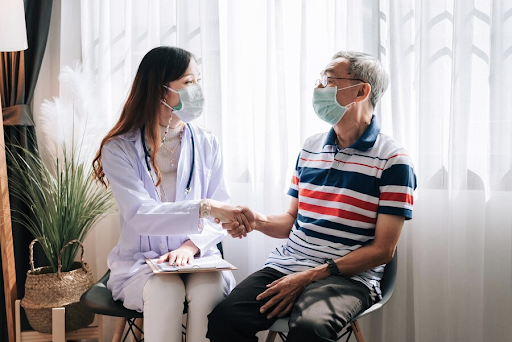Breathing Troubles: Understanding COPD Symptoms and Risk Factors

Breathing Better: The Unseen Value of Pulmonary Rehabilitation in COPD Treatment
31 May 2024
Chronic Obstructive Pulmonary Disease, more commonly known as COPD, is a long-term lung illness. In 2019, it caused the death of over 3 million people globally. India alone reported a total of 55.3 million COPD cases in 2016, making it the second most common cause of mortality in the country. If you or someone you know is facing this health challenge, it’s crucial to understand the different aspects of its management, particularly pulmonary rehabilitation.
Pulmonary rehabilitation, a targeted programme combining exercise training, education, and psychological support, is integral to comprehensive COPD treatment. This blog highlights the significance of these programmes and why they need more recognition.
With an understanding of the importance of pulmonary rehabilitation in COPD treatment, we can begin to delve deeper into how these programmes work and their wide-ranging benefits. So, let’s take a step forward together and unravel the nuances of pulmonary rehabilitation in managing COPD and why it’s proving to be a game changer in fostering better health outcomes for patients.
Unmasking COPD: A Breathing Battle
Chronic Obstructive Pulmonary Disease (COPD) is a chronic lung disease that makes breathing a difficult task. It can be life-changing and draining for the patient. The enemy here isn’t a single disease but a collective term for two major respiratory disorders: Emphysema and Chronic Bronchitis. While the former damages the air sacs in our lungs, the latter inflames the tubes that carry air to these sacs. This two-fold attack leaves its victims gasping for breath.
Pulmonary Rehabilitation: A Game Changer
Pulmonary rehabilitation has emerged as a comprehensive approach to managing COPD symptoms. It is an exercise-based programme that improves physical strength and endurance, complementing traditional COPD treatment.
The rehabilitation programme involves a team of healthcare professionals, including doctors, physiotherapists, and dietitians, who work together to develop an individualised plan for each patient. The aim is to alleviate symptoms, enhance life quality, and boost daily physical and emotional involvement. The blend of exercises and education creates an environment that empowers patients to take control of their condition.
The Power of Supervised Physical Activity
The heart of pulmonary rehabilitation lies in supervised physical activity. When participating in these controlled exercises, patients are closely monitored by trained professionals who ensure maximum benefit while minimising any potential risks associated with physical exertion.
Incorporating regular physical activity into a patient’s routine can improve overall health and well-being in numerous ways. Not only does it enhance physical strength and endurance, but it also lowers the risk of other illnesses, such as heart disease and diabetes. This multi-faceted approach addresses a patient’s various issues, leading to a comprehensive improvement in their quality of life.
Useful Tip: Sit firmly in a chair, tilt back slightly, lift your chest, and expand your front while deep breathing to make room for your lungs.
Decoding Heart Rate Variability
Heart Rate Variability (HRV) is an indicator of how our body responds to stress and recovers from it. COPD patients often exhibit decreased HRV, indicating an imbalance in the body’s autonomic nervous system, which controls heart rate, digestion, and other functions.
Studies have pointed out that a reduced HRV is linked with poor prognoses in cardiovascular diseases, which are common in people with COPD. This underlines the intricate relationship between our heart’s health and our lung function—a connection that needs careful management for effective COPD treatment.
A Healing Partnership: Exercise and Cardiac Autonomic Modulation

Exercise holds immense potential for treating COPD by positively impacting cardiac autonomic modulation—the way our heart responds and adapts to changes. Exercise offers more than just physical health benefits; it also aids mental well-being, which is crucial but overlooked in COPD care.
The beauty of pulmonary rehabilitation lies in its personalised approach. Each exercise routine is tailored to fit the patient’s capabilities and needs. This bespoke approach ensures that each individual gets the care they deserve while battling this challenging condition.
Summing it Up
To conclude, it’s quite clear that pulmonary rehabilitation plays a significant role in treating COPD. This multifaceted approach improves your physical strength and boosts your emotional well-being. From medication, including bronchodilators and inhaled corticosteroids for COPD, to physical exercises and nutritional counselling, every aspect of pulmonary rehabilitation works towards enhancing your quality of life. Remember, living with COPD isn’t about limiting your lifestyle; it’s about adapting it to manage the situation effectively and healthily.
At TatvaCare, we recognise the importance of providing comprehensive care for COPD patients. Our medical experts are committed to offering tailored treatment options, be it long-acting bronchodilators, combination therapy, or oxygen therapy for COPD. Your health matters to us. Feel free to contact us at tatvacare.in to learn more about our trusted services and embrace a journey towards better breathing.
FAQs
Q. Why is pulmonary rehabilitation important for COPD patients?
A: Pulmonary rehabilitation improves exercise capacity, reduces symptoms, enhances quality of life, and decreases hospitalizations in COPD patients.
Q. Who can benefit from pulmonary rehabilitation in COPD treatment?
A: COPD patients of all stages can benefit from pulmonary rehabilitation, especially those experiencing shortness of breath and reduced functional capacity.
Q. How long does pulmonary rehabilitation last, and how often should it be done?
A: Pulmonary rehabilitation programs typically last for several weeks to a few months, with sessions occurring 2-3 times per week.
Q. Are there any risks associated with pulmonary rehabilitation?
A: Risks are minimal when supervised by experienced healthcare professionals and typically related to the physical activity part of the programme. These can be effectively managed by tailoring exercise routines according to individual capabilities and continuously monitoring progress.
Q. Can pulmonary rehabilitation replace my current COPD medication?
A: No, pulmonary rehabilitation isn’t a substitute for your prescribed COPD medication. It’s an add-on therapy designed to complement your existing treatment plan.

Medically reviewed by
Dr. Devina Aswal 
MBBS, DDM, FCR, CIC
Recent Blog
- CDSS – Revolutionising Diagnosis with AI-Powered Clinical Decision Support System
- Handwritten to Digital in Seconds: SmartSync Converts Prescriptions Instantly
- Voice Rx by TatvaPractice: A Smarter Way to Digitise Prescriptions
- PCOS Facts vs. Myths: Get the Right Information
- The PCOS-Insulin Resistance Connection: Unlocking Solutions for Better Health
Archives
Categories
- Asthma (20)
- Diabetes (15)
- Fatty Liver (20)
- High Blood Pressure (2)
- High cholesterol (2)
- Hypertension (2)
- Insulin Resistance (1)
- Obesity (8)
- PCOS (6)
- TatvaPractice (11)
Let’s Connect
Quick contact



